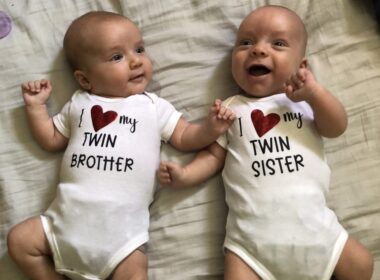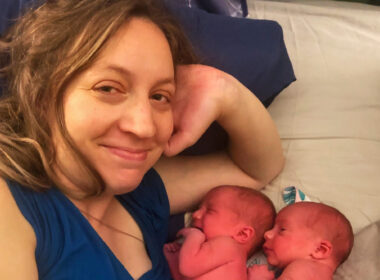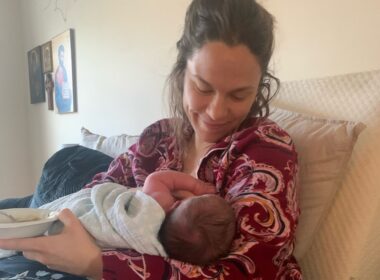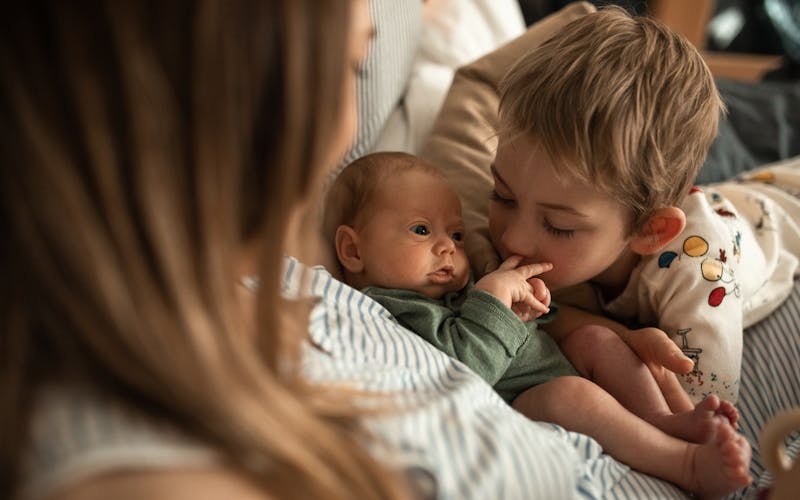When our second baby was born, our oldest was at an age where she generally accepted everything about birth as par for the course. No questions or deep thoughts. He was in Mommy’s belly, then he was at home. He ate Mommy’s milk, and that was that.
In the fall of her first year of preschool, we were in a season where I was neither pregnant nor breastfeeding. But many of my daughter’s preschool classmates were expecting siblings, so pregnancy was a popular topic in Ms. Elizabeth’s preschool classroom that year. And this time, my daughter was old enough to have a few questions about babies, birth, and mothering.
While many parenting resources will give you the (good!) advice to be the first one to talk to your kid about a topic, precisely because it will establish you as the “expert” your child turns to on that topic, I was admittedly thankful for Ms. Elizabeth, her age-appropriate responses to questions about babies and birth, and that I allowed our daughter to take the lead in our conversation.
If your kids are starting to ask questions about these things, too, (or you know the questions are coming, and want to be prepared) there are a few key things to remember when talking to kids about birth and babies.
When kids ask questions about birth
Maybe it is an age-thing, maybe a temperament thing—I’m not sure—but our daughter asks a question and then quickly answers it herself. If she allows us to answer, she will revise our answers to fit her own understanding.
So, when she asked how a baby gets inside a mommy’s belly, I paused to consider how to pare down my FEMM educator knowledge and package it nicely for a preschooler. That pause provided our daughter with just enough time to shout from her car seat, “NO! The Daddy gives the Mommy a seed to grow!” Just like that, because of this short explanation by her teacher, the question ‘how are babies made?’ was answered with a sufficiency that lasted another 2 years in our home. The oldest then had the language to respond to her toddler brother’s version of the question when I became pregnant with our third child.
Answering kids’ questions about babies
Towards the end of my pregnancy with our third baby, our oldest, now 5.5 years old, started asking how the baby would come out. She would check in every week with the same question—presumably to see if the answer would be the same. By then, I was more confident in my own simple response: “When the baby is ready, I will push the baby out of my vagina.”
How will we know when our baby is ready?
“She will tell Mommy’s body by sending a message inside my body.”
With a handful of simple responses, I was able to tell the truth (setting the foundation for future learning), answer the question asked, name body parts, and reassure our kids.
As you prepare to have conversations with your older kids about birth and bringing the baby home, trust that when you tell the truth in a succinct way with anatomically correct language and reassurance that you will continue to love your older kids, you will inform them in an age-appropriate manner, while building a strong foundation for family dialogue.
As you prepare to have conversations with your older kids about birth and bringing the baby home, trust that when you tell the truth in a succinct way with anatomically correct language and reassurance that you will continue to love your older kids, you will inform them in an age-appropriate manner, while building a strong foundation for family dialogue.
Four tips for talking with kids about conception, pregnancy, and birth
Tell kids the truth
Telling the truth with age-appropriate language helps to set the stage for future learning. Ms. Elizabeth started the conversation in our daughter’s preschool classroom by saying that the Daddy gives the Mommy a seed to grow. That explanation (which is an accurate, albeit highly simplified explanation of sex and conception–”sperma” in Greek literally means “seed!”) provided us with a fantastic starting point, one I’m not sure we would have found on our own.
We found that the foundation of a Daddy, a Mommy, a seed, and growth framed both physiological truths as well as our family’s particular faith and set of values. It’s a foundation which will serve us well as we transition into discussing anatomy, physiology, and procreation with age-appropriate intentionality.
Answer only the question asked
Whether we are discussing pregnancy or any other arena where nuance is required and increased understanding will come with greater development, we as parents do well to simply answer the question asked and–here’s the tricky part–nothing more.
When your child asks a question, answer her question in the most basic, fundamental way possible, then wait for her to decide if she has another question, or if your answer satisfies her–which is oftentimes the case, especially with younger children. Although it can be tempting, adding more information than she asked for is more information than she besoins–and doing so may only confuse your child.
Use anatomically correct language
Il y a many benefits to kids learning anatomically correct language. While using anatomically correct language for body parts may feel uncomfortable to you at first, remember that to your kids, they’re just words, and no different from anything else. When vous normalize the use of anatomically correct language within respectful and developmentally appropriate contexts, your kids will in turn use anatomically correct language respectfully and in developmentally appropriate contexts.
A simple dialogue we kept coming back to in our house was about preparing our kids for Mommy to heal after the baby came out. Adding onto the explanation of how the baby would come out of my body, our kids heard:
“When the baby is ready, I will push the baby out of my vagina. When Baby comes out, there will be a wound (clarified as ‘boo-boo’ when asked) inside Mommy that will need to heal.”
Reassure older siblings
While bringing a new baby home (or having a baby at home) is a big deal and a huge transition, speaking about it like it is a normal and natural event (since it is!) allows the transition to be seen as normal and natural by your children.
Having conversations about new rhythms and routines with the new baby can help prepare older siblings for the first few weeks of life with a newborn.
In the leadup to birth, conversations about life after birth can focus on how we can snuggle our new baby and read a lot of books, and eventually do crafts, build, and bake together while we care for Mommy and our new baby. The emphasis was on reassuring the older kids that Mommy will need to slow down for a while et we will still have fun together.
Things will change, but it will be a natural and normal event in our family’s story.
An important note about other adults talking to your kids about babies and birth
When my daughter first came home from preschool talking about where babies come from, I was admittedly a little surprised. But Ms. Elizabeth (a pseudonym) handled it in an age-appropriate, straight-forward manner, that was in alignment with our family’s faith background and values. She was also transparent about it; she shared with us in her weekly classroom email that the topic had been discussed (and shared the language she used), explaining that “many mommies are expecting and there are many excited classmates.”
We also knew (and were aligned with) the faith-based background of the church preschool, the training of the teachers, and had built up strong relationships there. Had we been brand-new to the school, or if the information had come from a teacher with whom we had had negative experiences, we would have been concerned–and expressed those concerns.
The bottom line is this: as your children’s parents, you are their primary educator, and you reserve the right to express concerns with what your children are being taught, especially if they are not in alignment with your particular values or faith background. (And if you want help with the important task of framing puberty, fertility, pregnancy, and birth as a normal, natural, and healthy part of life, Natural Womanhood’s Period Genius course is an excellent resource for that!)
Remember: Don’t complicate things
So, to reiterate: When your children ask questions about conception, babies, and birth, don’t panic! Just be sure to:
- Tell the truth
- Answer only the question asked
- Use anatomically correct language
- Reassure older siblings
As you have conversations with your older kids about birth and bringing the new baby home, trust that telling the truth in a succinct way while using anatomically correct language and reassuring your older kids of your love for them will build a strong foundation for family dialogue.
Short, honest, and consistent responses helped our kids build scripts as they grew in their understanding of birth and bringing their new sibling–and they can do the same for yours.







